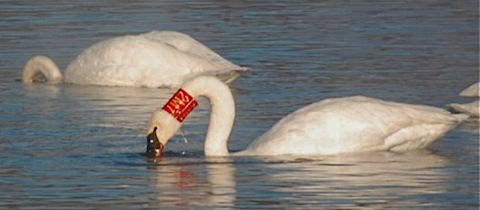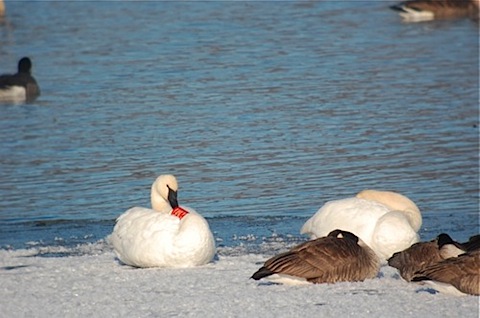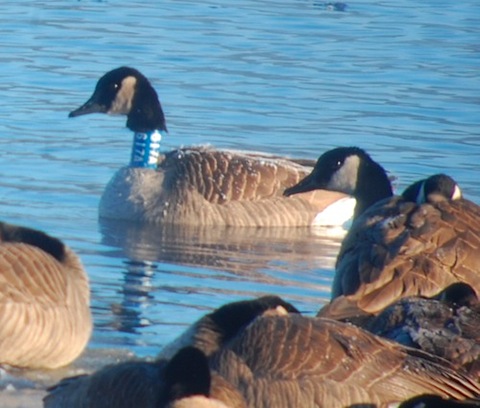
So, when I was out looking at the harlequin duck last week, I found a few banded birds at Point Douglas. It's not the first time, last winter I got video of a banded trumpeter swan. I sent the band info along to the Bird Banding Lab and it turned out the bird was from Iowa. I saw the above swan with a neck band and noticed that it had a different code and sent that along to the lab. I'm still waiting to see where this bird came from. But notice how the band is moving up and down the swan's neck. Above, the bird is just taking its head out of the water and the band has slid towards the head.

Here that same swan is preening and you can see that the band has moved back down. These types of bands are used on swans and geese to track individuals and where they are going. There's no way you'd be able to do id that particular swan with just a leg band (even if they are out of the water). Those metal bands on the legs are too tiny to read. But the bright plastic neck bands are easy to spot and read with a scope or binoculars. Because of the reintroduction program with trumpeter swans, it's not out of the ordinary to see one here and there.

It is, however, unusual to see bands on a Canada goose these days. You used to see it all the time with the Canada goose reintroduction in the 1980s but by now it's an understatement to say that the geese are well established so it's not so common. But what really struck me about this goose was how tight the neck band appeared. I took this photo the same day, during the same time period as I did the trumpeter swan. The goose's band did not move like the swan's neck band did. It did not look comfortable at all. At first, I thought that maybe this was a fluke that maybe I caught this bird at a bad angle, but all my photos look the same, the band looks tight and does not move no matter what position the goose was in.
Then, earlier this week, this story appeared in the Duluth paper about a Canada goose that had Ice build up on its neck band. If you follow the link, you can see photos--the ice is about the size of a dinner plate. It has a happy ending, rescuers were able to get the goose and remove the ice and the collar but it has me questioning neck bands used for Canada geese.
I have to say, I'm a bander, and I see the value of neck bands--I truly do. But I think we need to rethink how neck collars are designed for some species. Even if the Canada goose in my photos is fine and the BBL backs it up with research and studies that say those collars look bad but are comfortable and fine for the geese--it's not a good advertising for banding. If someone knows nothing about banding saw that, they'd have a hard time seeing the value of banding and that it's not harmful for the banded birds.
